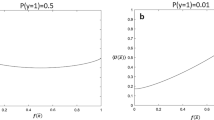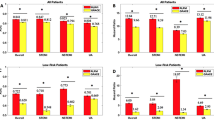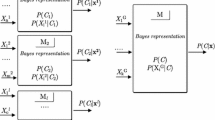Abstract
The objective of this study was to distinguish within a population of patients with known or suspected coronary artery disease groups at high and at low mortality rates. The study was based on Cleveland Clinic Foundation's dataset of 9454 patients, of whom 312 died during an observation period of 9 years. The Logical Analysis of Data method was adapted to handle the disproportioned size of the two groups of patients, and the inseparable character of this dataset – characteristic to many medical problems. As a result of the study, we have identified a high-risk group of patients representing 1/5 of the population, with a mortality rate 4 times higher than the average, and including 3/4 of the patients who died. The low-risk group identified in the study, representing approximately 4/5 of the population, had a mortality rate 3 times lower than the average. A Prognostic Index derived from the LAD model is shown to have a 83.95% correlation with the mortality rate of patients. The classification given by the Prognostic Index was also shown to agree in 3 out of 4 cases with that of the Cox Score, widely used by cardiologists, and to outperform it slightly, but consistently. An example of a highly reliable risk stratification system using both indicators is provided.
Similar content being viewed by others
References
E. Boros, P.L. Hammer, T. Ibaraki and A. Kogan, Logical analysis of numerical data, Mathematical Programming 79 (1997) 163–190.
E. Boros, P.L. Hammer, T. Ibaraki, A. Kogan, E. Mayoraz and I. Muchnik, An implementation of logical analysis of data, IEEE Transactions on Knowledge and Data Engineering 12(2) (2000) 292–306.
R.M. Califf, P.W. Armstrong, J.R. Carver, R.B. D'Agostino and W.E. Strauss, Stratification of patients into high, medium and low risk subgroups for purposes of risk factor management, J. Amer. Coll. Cardiol. 27(5) (1996) 1007–1019.
C.R. Cole, E.H. Blackstone, F.J. Pashkow, C.E. Snader and M.S. Lauer, Heart-rate recovery immediately after exercise as a predictor of mortality, N. Engl. J. Med. 341(18) (1999) 1351–1357.
D. Cox, Regression models and life tables (with discussion), J. Roy. Statist. Soc. Ser. B 34 (1972) 187–220.
Y. Crama, P.L. Hammer and T. Ibaraki, Cause-effect relationships and partially defined Boolean functions, Annals of Operations Research 16 (1988) 299–326.
O. Ekin, P.L. Hammer and A. Kogan, Convexity and logical analysis of data, Theoretical Computer Science 244 (2000) 95–116.
P.L. Hammer, Y. Liu, B. Simeone and S. Szedmak, Saturated systems of homogeneous boxes and the logical analysis of numerical data, Annals of Operations Research (forthcoming), RUTCOR Research Report RRR 19–2000, RUTCOR, Rutgers University, Piscataway, NJ (2000).
P.L. Hammer, Partially defined Boolean functions and cause-effect relationships, in: International Conference on Multi-Attribute Decision Making via OR-Based Expert Systems, University of Passau, Passau, Germany (1986).
D. Hosmer and S. Lemeshow, Applied Logistic Regression (Wiley, New York, 1989).
J.M. Kwok, T.D. Miller, T.F. Christian, D.O. Hodge and R.J. Gibbons, Prognostic value of a treadmill exercise score in symptomatic patients with nonspecific ST-T abnormalities on resting ECG, J. Amer. Medical Assoc. 282(11) (1999) 1047–1053.
M.S. Lauer, S. Alexe, C.E. Pothier Snader, E.A. Blackstone, H. Ishwaran and P.L. Hammer, Use of the “Logical Analysis of Data” method for assessing long-term mortality risk after exercise electrocardiography, Circulation 106 (2002) 685–690.
M.S. Lauer, G.S. Francis, P.M. Okin, F.J. Pashkow, C.E. Snader and T.H. Marwick, Impaired chronotropic response to exercise stress testing as a predictor of mortality, J. Amer. Medical Assoc. 282(6) (1999) 524–529.
D.B. Mark, M.A. Hlatky, F.E. Harrell, Jr., K.L. Lee, R.M. Califf and D.B. Pryor, Exercise treadmill score for predicting prognosis in coronary artery disease, Ann. Intern. Med. 106(6) (1987) 793–800.
D.B. Mark, L. Shaw, F.E. Harrell, Jr., M.A. Hlatky, K.L. Lee, J.R. Bengtson et al., Prognostic value of a treadmill exercise score in outpatients with suspected coronary artery disease [see comments], N. Engl. J. Med. 325(12) (1991) 849–853.
T.H. Marwick, R. Mehta, K. Arheart and M.S. Lauer, Use of exercise echocardiography for prognostic evaluation of patients with known or suspected coronary artery disease, J. Amer. Coll. Cardiol. 30(1) (1997) 83–90.
E.O. Nishime, C.R. Cole, E.H. Blackstone, F.J. Pashkow and M.S. Lauer, Heart rate recovery and treadmill exercise score as predictors of mortality in patients referred for exercise ECG, J. Amer. Medical Assoc. 284(11) (2000) 1392–1398.
G. Rose, The Strategy of Preventive Medicine (Oxford University Press, New York, 1992).
D.A. Weiner, T.J. Ryan, L. Parsons, L.D. Fisher, B.R. Chaitman, L.T. Sheffield et al., Long-term prognostic value of exercise testing in men and women from the coronary artery surgery study (CASS) registry, Amer. J. Cardiol. 75(14) (1995) 865–870.
Author information
Authors and Affiliations
Rights and permissions
About this article
Cite this article
Alexe, S., Blackstone, E., Hammer, P.L. et al. Coronary Risk Prediction by Logical Analysis of Data. Annals of Operations Research 119, 15–42 (2003). https://doi.org/10.1023/A:1022970120229
Issue Date:
DOI: https://doi.org/10.1023/A:1022970120229




